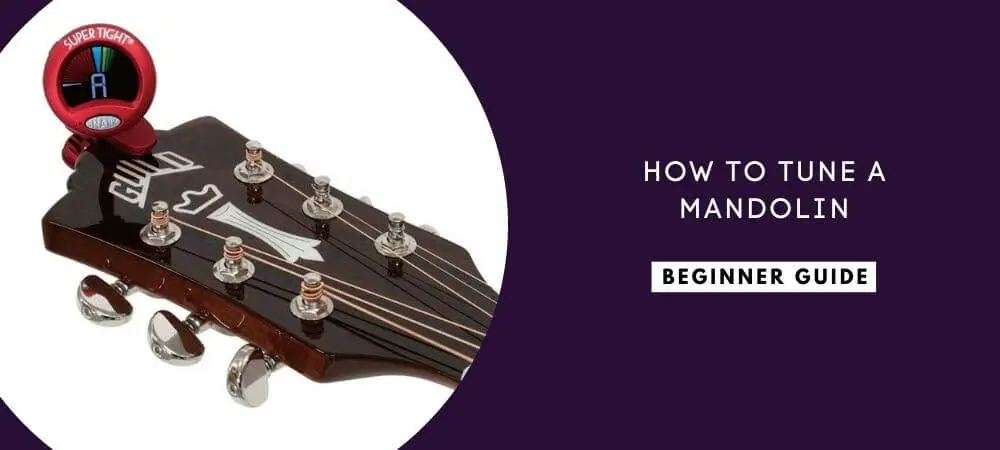Tuning a mandolin isn’t a one-time thing where you have your instrument professionally tuned and forget all about it. On the contrary, this is a repetitive thing that you might end up doing every time you pick up your mandolin to play it.
For this reason, every player should master the art of how to tune a mandolin. So, where do we start?
Table of Contents
Mandolin Tuning Basics
How Can You Tell If A Mandolin Is Out Of Tune?
As you keep playing, you will become very good at detecting when your mandolin is out of tune, and so when playing a song you’re familiar with, you will be able to tell whether or not it sounds right.
Also, you can use online tuners such as a tuning app, which will give you a reference tone, and you can use this to check whether each individual string sounds right.
One tone has 100 cents, and generally, people with a pretty good pitch can detect +/- 3 cents tuning by ear. Of course, if you are yet to develop a good ear, your sense of pitch will be far less precise.
A mandolin player with a sensitive pitch will re-tune far more often than someone newer to the mandolin and might not even notice the instrument is out of tune.
What Is The Standard Mandolin Tuning?
The only difference is that while violins have 4 strings, a mandolin has 4 sets of 2 strings tuned to the same pitch. So ideally, taking into account the individual strings, the 8 mandolin strings are actually tuned to G-G-D-D-A-A-E-E.
When holding the mandolin in the correct playing position, the E strings, which is the highest string pair, should be closest to the floor.
If you play the guitar, think of the mandolin strings as being similar to the lowest four guitar strings (E-A-D-G), only in reverse. Likewise, guitar chords are similar to mandolin chords but in reverse.
Will I Need To Change Strings?
Worn out rusty strings tend to go out of tune more quickly, and they are even harsher on your fingers while you play. Of course, this is not to say you should change your strings every single time you are playing.
Instead, try doing so regularly, say about every 4-6 weeks of moderate or heavy usage.
Besides using fresh strings, it is also crucial to pay attention to the type of mandolin strings you are using. Coated strings and flatwound strings are known to hold their tuning much better than other strings.
Which Tuning Peg Corresponds To Which String?
Before you start tinkering with anything, you first need to locate the correct tuning pegs for each string. There are 8 tuners in total, one for each string, and typically, most mandolins use the same system for positioning the tuning pegs.
The tuners for the G string pair and the D string pair are usually located on the upper side of the headstock that’s closest to you when you hold the mandolin correctly. On the other hand, the tuners for the A and E strings are located on the lower side that’s closest to the floor.
How Do You Tune A Mandolin: Step by Step
Tip 1: Tune From Lowest to Highest Pitch
The tuners are placed in order, meaning you will work in a clockwise pattern around the headstock, from the top G string tuner, working clockwise all the way to the last tuner, which controls the second E string.
This clockwise pattern is exactly how you are supposed to tune your instrument, starting from the lowest string pitch that is the G strings, and finishing with the highest pitch string, which is the E string.
Tip 2: Tune In Pairs
While working clockwise around the headstock, the idea is to tune each string individually, then in pairs.
It would be tough to tell which string is out of tune if you tune them at a time, striking them both as one. So instead, tune each string individually, then strike it using a pick and not your fingers so that you can precisely tell which string you are playing.
Once you’ve tuned both strings in a course, play them consecutively, listening closely so that you can tell whether they sound similar to each other. If they don’t, adjust the strings accordingly until the paired strings sound exactly alike.
While doing this, it would be advisable to use ‘rest strokes,’ meaning you essentially dampen each string with the pick after you play it. This will allow you to individually isolate each note, thereby giving you a clearer tone as you tune the mandolin.
Tip 3: Start With A Rough Tuning Then Fine-Tune It
When working with new strings, it can be frustrating to get the perfect pitch from your instrument immediately.
The reason behind this is that fresh strings put a lot of tension on the neck so much that the wood will even flex slightly, therefore causing the freshly tuned string to slip out of tune after just a few minutes.
For this reason, whether working with old or new strings, it is always best to tune each string to a ballpark pitch at first, getting as close to the correct pitch as you possibly can. Let the instrument rest for a few minutes, then go back and fine-tune each string.
This will make your tuning process much easier, faster, more accurate, and less frustrating.
Tip 4: Double-Check
After you have tuned the E strings, double-check your tuning by going back to the first string and working your way back to the E strings.
Mandolins can go out of tune even while you are in the process of tuning the instrument because the mandolin is set up such that the tension of a single string affects the tuning of all the other strings.
So, once you are relatively satisfied with the tuning, go back and make fine adjustments to each string to guarantee that each pair has the perfect pitch.
Tip 5: Tune Up, Not Down
As with all other stringed instruments, you need to tune the mandolin up instead of tuning it down.
This means that you tune each string from a flat to a sharp pitch, rather than starting with a higher note then tuning down to the right note. Start from a pitch below the intended tuning, then tune up to your intended pitch.
The idea is to settle the tension in the string towards the tuning gear and not away from it. When you tune down, you run the risk of having the tension slip on the tuning gear as you play, and this will make the string go flat and out of tune much quicker.
Additionally, when you tune down, you run the risk of increasing the tension on your string which can cause it to snap.
How To Tune A Mandolin With An Electronic Tuner
Types Of Electronic Tuners
Chromatic Tuners are the most popular amongst mandolinists, and they come as a clip-on tuner that attaches to the end of your headstock. How these electronic tuners work is that when you pluck a string, a tiny screen displays what pitch you are at, then it is up to you to tune the string to the ideal note.
Besides being easy to use, this clip-on tuner is also pretty convenient, seeing as you can leave it clipped onto your mandolin, ready to fine-tune the strings at a moment’s notice during practice sessions or gigs.
Fixed Tuners are often considered guitar tuners, so this kind of electric tuner isn’t very popular with mandolin players. This guitar tuner can only register certain pitches, which is not as helpful as the chromatic tuner.
How To Use An Electronic Tuner
1. Find a quiet room to tune in, so that surrounding noise does not affect the tuner’s efficacy.
2. Clip your tuner onto the mandolin, turn it on, and ensure it is picking up the sound.
3. Check your instrument’s intonation and if necessary, adjust the ridge accordingly.
4. Starting with the G string, play each string individually and tighten the corresponding tuner until you get the string daily close to the correct pitch. It doesn’t have to be perfect at this point.
5. Continue tuning each of the strings, tightening the relevant tuning peg as you go and ensuring the other strings are in line with the G strings.
6. Once you are done with the last E string, go back through and have another go at it. This time, fine-tune your tuning as closely as possible.
7. All along, watch the electronic tuner for cues because most of them will indicate whether you’re sharp or flat, and when you are at the perfect pitch, the tuner will give an indicative signal.
8. Play all double strings to confirm they are in tune. If not, repeat the process until you get a tone you are satisfied with.
While the aim is to get every note playing the perfect pitch, the instrument should be tuned to itself more importantly. This means that unless you are playing the mandolin with others, the goal isn’t to get the perfect pitch but rather to have the instrument sounding great to you.
This is why as much as you are using an electronic tuner, concentrate keenly by using your ears as well.
How To Tune A Mandolin By Ear
There are moments when you might not have a tuner at hand. So how can you still ensure your instrument plays great? Tune it by ear, of course. Granted, this technique best suits experienced players rather than beginners who have not yet trained their ears to be sensitive to the slightest pitch changes.
The reference point used could be an online tuner in the form of an app on your smartphone, or it could be another instrument. For the latter, you can use a guitar, banjo, or piano that’s in tune.
All the G-D-A-E strings corresponding to a mandolin’s tuning are present on other acoustic instruments. Remember that the mandolin uses G3-D4-A4-E5, whereby the numbers indicate the octave you should tune the string to.
1. Have your partner play a G on the other instrument that’s in tune, then play a single G string on your mandolin.
2. If your mandolin sounds higher, tune it lower and vice versa.
3. Move on to the D and repeat the same process, the idea being to play each note on your in-tune instrument and use that to match your corresponding string sound.
4. When you are done, double-check your mandolin tuning by repeating the same process starting with the first G string.
Other Methods To Tune Your Mandolin
Tuning The Mandolin To Itself
1. Start by tuning the E strings together to have a similar pitch. You will then use these tuned E strings to generate a tone for the other strings.
2. Play your E string ‘open’ or unfretted, then play a single one of your A strings at the seventh fret. These two should play the same note, so the string sound should be similar.
3. If they don’t, adjust the tuning of each A string, the aim being to match it to the pitch of your E string played unfretted.
4. Once that is done, and you are happy with the tone, play one of your D strings on the seventh fret and tune it to sound like your A string when played unfretted.
5. Repeat this process for the remaining lower strings until all strings are tuned.
6. When you are done, double-check your tuning by repeating the same process starting with the last E string.
Using A Tuning Fork
Simply strike the fork against a hard surface and use the generated tone as a reference for the pitch of the string. An E tuning fork is the most useful for the mandolin, which will help you tune your E strings. Once the E strings are in tune, you proceed to tune the instrument to itself as directed above.
Mandolin Tunning FAQs
Are Mandolins Hard To Tune?
Yes, they are.
It is challenging to tune a mandolin because the instrument has shorter strings than a guitar, so it takes time and skill to narrow in on the correct pitch. Additionally, the fact that a mandolin has 8 strings tuned in pairs makes it much harder to get each pair of strings to sound in tune.
What Is The Best Mandolin Tuner?
The best mandolin tuner in our opinion is the Snark Tuner. It’s one of the most recommended tuners in the mandolin community today.
Can I Tune A Mandolin With A Guitar Tuner?
Yes, you can, and the video below will illustrate just how to go about this.
How To Tune A Mandolin With A Piano?
Tuning a mandolin with a piano is actually easier than you would imagine. See the video below to see what I mean.
Conclusion
Tuning the mandolin might seem unnecessarily tasking at first. However, getting used to tuning the mandolin will help you develop your pitch sensitivity so you can better recognize microtones, as well as flat and sharp sounds.
Developing this sharp sense where you can recognize pitches by ear will make you a far better mandolin player in the long run.






